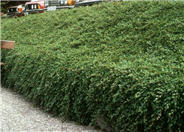
Common name:Holly Oak, Holm Oak
Botanical name:Quercus ilex
This evergreen oak has a moderate growth rate to 30'-60' tall and as wide. The leaves are variable in size and either toothed or smooth-edged, resembling a holly. It has a rich, dark green leaf color. Acorns are a source of food for wildlife. Yellow flowers appear in the spring. This oak prefers full sun and is drought tolerant after it's established. It tolerates coastal conditions and can be used as a windbreak.

Common name:California Coffeeberry
Botanical name:Rhamnus californica
The California Coffeeberry is an evergreen shrub that reaches 3'-15' high. It has red berries that turn black in late summer, which attracts birds. This shrub tolerates sun or partial shade in all soil types. This CA native is drought tolerant once it's established. It is a beneficial insect plant and attracts butterflies. In ocean areas, this plant looks more like a ground cover. Small flowers appear in spring but are considered insignificant.

Common name:Bearberry Cotoneaster
Botanical name:Cotoneaster dammeri
This prostrate, trailing evergreen shrub is primarily used as a ground cover. It is highlighted with bright green, ovate to rounded leaves with prominent veins. In the fall, Bearberry Cotoneasters are accented by small, bright red berries. This ground cover gets only 1' tall but will spread 5' wide. This is a great plant for banks or hillsides as long as it gets full sun. It becomes drought tolerant once it's established. Small white flowers appear in spring.

Common name:Prostrate Rosemary
Botanical name:Rosmarinus officinalis 'Prostratus'
The 'Prostratus' grows to a height of 2'-3' with a spread to 8'. Its flowers are pale, lavender-blue in color, and the leaves are needle-like with a dark, blue-green color. This plant makes a good ground cover, and its leaves can be used as seasoning in cooking. Bloomtime is winter and spring, but also intermittently throughout the year. This ground cover like full sun and well draining soil. It is drought tolerant once it's established.
| Designer: Sacramento Suburban Water Dist | Suburban Street Planting Fall |
Photographer: GardenSoft |
Soils and Compost:
Physical weed control, including mulching, or hand removal protects the watershed from harmful chemicals.
Water Saving Tip:
Apply as little fertilizer as possible.
If you use fertilizer make sure it stays on the landscape, and carefully water it in so there is NO runoff.
Integrated Pest Management:
Drip and other smart irrigation delivers water directly to roots, allowing no excess water for weeds.

